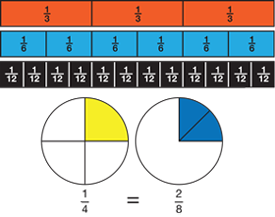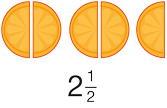Students use fraction circle pieces to model the subtraction of mixed numbers and to develop paper-and-pencil procedures. They use add mixed numbers to check their subtraction. Students play Closest To, a game involving estimation and subtraction.
Content in this Lesson
- Representing subtraction of mixed number fractions with fraction circle pieces, number lines, and number sentences [E3].
- Adding and subtracting mixed number fractions including those with unlike denominators using fraction circle pieces and paper-and-pencil methods [E8].
- Solving word problems involving subtraction of mixed number fractions [E5].
- Finding equivalent fractions using tools (e.g., area models, number lines) and multiplication and division strategies [E1].
- Finding common denominators and using them to subtract and compare fractions [E10].
- Estimating differences of mixed number fractions using benchmarks and mental math strategies [E9].
- Representing and identifying the simplest form of a fraction using tools (e.g., area models) and multiplication and division strategies [E2].
- Choosing appropriately from among estimation and computation strategies [E7].
- Finding strategies for adding and subtracting mixed numbers [MPE2].
- Using estimation and addition to check subtraction problems [MPE3].
- Knowing the question to answer and what is important in a word problem [MPE1].
- Using labels to show what numbers mean [MPE6].
Daily Practice and Problems O–R
Assessment in this Lesson
| Assessment | Expectation Assessed | Math Practices Expectation Assessed |
|---|---|---|
|
Subtract Mixed Numbers |
|
|
|
DPP Item O |
|














 and
and  since 15 is divisible by both 3 and 5.
since 15 is divisible by both 3 and 5.  and
and  .
. ,
, ,
, are equivalent to each other, and
are equivalent to each other, and  and
and  are equivalent to each other.
are equivalent to each other.
 .
.